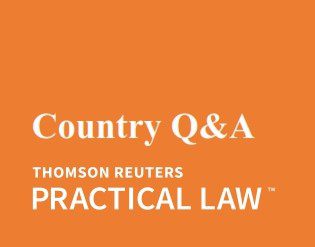The Mergers & Acquisitions Review provides a practical overview of global M&A activity and the legal and regulatory frameworks governing M&A transactions in major jurisdictions worldwide. With a focus on recent developments and trends, it examines key issues including relevant competition, tax and employment law considerations; financing; due diligence; and much more.
Author: afridi-angell
Service of claim documents within the jurisdiction and abroad Q&A: DIFC
DIFC-specific information setting out the framework for service of claim documents (in relation to domestic and foreign proceedings) within the jurisdiction, and service of claim documents outside the jurisdiction.
Recovery of trade debts Q&A: (DIFC)
This Q&A is DIFC specific information on the legal options available to parties looking to recover a trade debt including ordinary legal proceedings, special fast-track procedures (if any), insolvency proceedings and amicable settlement opportunities.
This Q&A also provides United Arab Emirates commentary on Practice note and Recovery of trade debts: a cross-border overview.
Rules of evidence (including cross-border) in civil proceedings Q&A: (DIFC)
This Q&A provides an overview of the rules of evidence in civil proceedings, including rules on the disclosure obligations of the parties, admissibility of evidence, witness evidence, the standard of proof, as well as issues that arise in gathering cross-border evidence.
The International Capital Markets Review (UAE chapter), 12th edition
This volume will prove to be a useful guide investigating the international capital markets. The book itself covers multiple jurisdictions, however this chapter is dedicated to the analysis of the market situation in the United Arab Emirates in 2022. It not only contains multiple relevant sub topics (such as developments affecting debt and equity offerings, the tax and insolvency law, developments affecting derivatives, securitisations and other structured products and more ), but it also provides strategic considerations to take into account and to gain that broad understanding and what may lie ahead.
Tax Residency in the UAE: who qualifies as a UAE Tax Resident?
Recently approved Cabinet Decision 85 of 2022 (the Decision) outlines the requirements and conditions for classification of persons as a “Tax Resident” of the UAE. We briefly outline below who qualifies as a UAE tax resident.
Afridi & Angell have assisted a variety of clients in procuring tax domicile certificates and are well versed in the procedures and requirements. If you are interested in learning more about whether you may qualify as a Tax Resident, or the procedures for obtaining a tax domicile certificate, please reach out to one of our team members. Tax domicile certificates are an important and valuable component in the tax-planning structures that we implement for many of our clients.
Companies as UAE Tax Residents
Article 3 of the Decision provides that a company shall be deemed as a Tax Resident where it meets one of the following criteria:
(1) it is established, formed or recognised according to the legislation in force in the UAE. The Decision expressly excludes branches of foreign companies registered in the UAE from the definition of a Tax Resident; or
(2) it is otherwise deemed as a Tax Resident by virtue of a different federal law imposing tax (Tax Law).
Natural Persons as UAE Tax Residents
Article 4 outlines the requirements for a natural person and provides that such a person shall be deemed as a Tax Resident where they meet one of the following conditions:
(1) the habitual or primary place of residence of the individual is located in the UAE, so long as it is considered to be the place of fiscal and personal interests of the individual and where it meets the conditions and standards as applicable and determined from time to time;
(2) the individual is physically present in the UAE for a minimum of 183 days, within the duration of 12 consecutive months; or
(3) the individual may qualify as a Tax Resident where they have been physically present in the UAE for a minimum of 90 days within the relevant duration of 12 consecutive months, if the individual holds UAE nationality or a valid UAE Residence Permit or the nationality of any of the GCC Countries, and meet either of the following conditions:
a. the individual holds a “Place of Permanent Residence” in the UAE; or
b. the individual holds a position or is exercising “Activities” in the UAE.
A “Place of Permanent Residence” means a place located in the UAE which is deemed available to the individual at all times and “Activities” includes any activity practiced on a regular, ongoing and independent basis by a natural person.
The Decision provides that any person deemed as a Tax Resident in the UAE may submit an application to the Federal Tax Authority for issuance of a tax domicile certificate. ■
UAE Federal Decree Law 47 of 2022 on Taxation of Corporations and Businesses
January 2022 began with the announcement that businesses and corporations will be subject to Corporate Tax (CT) from 1 June 2023. While the UAE Ministry of Finance helpfully provided information on the basic tenets of CT, including a comprehensive white paper, the CT Law governing CT was published on 9 December 2022 providing clarity. However, there are still a number of areas that will be further clarified through the implementing regulations. An unofficial translation of the Law together with FAQs have been provided by the MoF.
Who will be liable to pay CT?
Both corporate entities and individuals who conduct Business/Business Activity in the UAE are considered a Taxable Person and will be liable to pay CT. A Taxable Person can either be a Resident Person or a Non-Resident Person (including Branches, Partnerships and Foundations).
A Resident Person includes:
– a company/establishment that is established in the UAE;
– a foreign company/establishment that is effectively managed and controlled in the UAE; or
– an individual who conducts business activities in the UAE.
A Non-Resident Person is a person who is not considered a Resident Person that:
– has a permanent establishment in the UAE;
– derives state sourced income; or
– has a nexus to the UAE, as to be specified by the Cabinet of Ministers.
Who is exempt from CT?
The following persons are exempt from CT:
1. Government entities;
2. a Government Controlled Entity;
3. a Person engaged in an Extractive Business, that meets the conditions of Article 7 of the Law;
4. a Person engaged in a Non-Extractive Natural Resource Business, that meets the conditions of Article 8 of the Law;
5. a qualifying Public Benefit Entity (Charities) under Article 9 of the Law;
6. a qualifying Investment Fund under Article 10 of the Law;
7. a public pension or social security fund, or a private pension or social security fund that is subject to regulatory oversight of the competent authority in the UAE;
8. an entity incorporated in the UAE that is wholly owned and controlled by an Exempt Person that meets the required conditions specified under paragraphs (a), (b), (f) and (g) of Clause 1 of Article 4 of the Law; or
9. any other Person as may be determined by the Cabinet of Ministers.
What about Free Zones?
The Law provides that CT shall be imposed on a “Qualifying Free Zone Person” at the following rates:
– 0 percent on Qualifying Income; and
– 9 percent on Taxable Income that is not Qualifying Income.
A Qualifying Free Zone Person is defined as a person that meets the condition set out in Article 18 of Law, which includes maintaining adequate substance in the UAE, derives Qualifying Income and has not elected to be subjected to CT.
“Qualifying Income” is to be specified further by the Cabinet of Ministers.
Importantly, all Free Zone entities will be required to register and file a CT return, irrespective of whether they are a Qualifying Free Zone Person or not.
What will be taxed (Taxable Income)?
A Taxable Person will be taxed on its worldwide taxable income, regardless of whether the income is derived within or outside the UAE, which will be determined on the basis of the net profit (or loss) in financial statements prepared for financial reporting purposes in accordance with acceptable accounting standards.
Also, international agreements (including those for the avoidance of double taxation) should be considered with respect to the CT regime.
What is the CT Rate?
CT will be levied at a rate of 9 percent on Taxable Income that exceeds AED 375,000. Taxable Income below AED 375,000 will be subject to a 0 percent rate.
What about Tax Losses?
Tax Losses can be offset against Taxable Income of future periods up to a maximum of 75 percent of Taxable Income for each of such future periods. Any excess, unused Tax Losses can be carried forward and used later.
What about Transfer Pricing?
The UAE will implement Transfer Pricing rules broadly in line with the OECD Transfer Pricing Guidelines and require periodic Transfer Pricing reporting obligations.
Are there Anti-Abuse Rules?
The CT contains anti-abuse rules to prevent abuse or avoidance of the CT Law. The Federal Tax Authority (FTA) may make a determination, in a ‘just and reasonable’ manner, that one or more specified CT advantages obtained as a result of a transaction or arrangement are to be counteracted or adjusted if, having regard to all relevant circumstances, it can be reasonably concluded that:
- the entering into or carrying out of the transaction or arrangement, or any part of it, is not for valid commercial or other non-fiscal reason which reflects economic reality; and
- the main purpose or one of the main purposes of the transaction or arrangement, or any part of it, is to obtain a CT advantage that is not consistent with the intention or purpose of the CT Law.
A CT advantage includes but is not limited to:
- a refund or increased refund;
- avoidance or reduction of CT payable;
- deferral of a payment of CT or advancement of a refund of CT; and
- avoidance of an obligation to deduct or account for CT.
When do you have to file a tax return and pay CT?
A Taxable Person must file a tax return and pay the CT no later than nine months from the end of the relevant Tax Period. The FTA will be responsible for the administration, collection and enforcement of CT and other federal taxes.
***
Please contact us if you have any comments or queries with respect to this law. ■
Banking & Finance (UAE chapter)
The Chambers Banking & Finance 2022 guide covers 46 jurisdictions. This chapter guide provides the latest legal information on the impact of the COVID-19 pandemic; environmental, social and governance (ESG) lending; restrictions on foreign lenders and foreign currency exchange; tax and usury laws; guarantees and security; enforcement of foreign judgments; bankruptcy and insolvency; and project finance.
Attachment of assets
Attachment of Assets is designed to give practical information and guidance to lawyers and businessmen who are interested in securing expected future judgments and in making strategic decisions concerning the deployment of moveable assets in the face of possible attachments of them. This chapter, discusses the requirements of the United Arab Emirates which is written by our (Afridi & Angell) lawyers who are experts in the field.
The Energy Regulation and Markets Review (UAE chapter), 11th edition
In our eleventh year of writing the UAE chapter of The Energy Regulation and Markets Review, COVID-19, now in its third year, continued to create challenges in 2021 and the early part of 2022. It has produced a domino effect, resulting in a reduction in investments, relative delays in projects and a cascade of other obstructions confronting the energy sector in the UAE. However, the focus of the UAE has remained on its strength in mass generating electricity from renewable energy sources.
The UAE has long been at the centre of technological developments and is now using innovative technology in the power sector, which was reflected in its overall ranking at 33 on the World Energy Council’s Energy Trilemma Index in 2021.
The UAE is geared up for and appears to be on track to deliver its Energy Strategy 2050, which was launched in 2017. Backed by impressive technology, the country is well equipped to meet ever increasing energy demands and to create smart and efficient energy production and use. Energy efficiency remains very much at the top of the UAE’s energy agenda.
In addition to the focus on the energy sector at home, the UAE is also collaborating with and investing in other countries.





